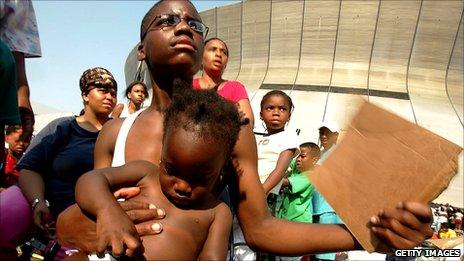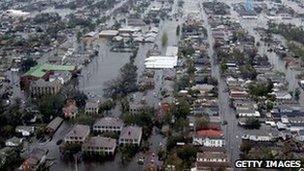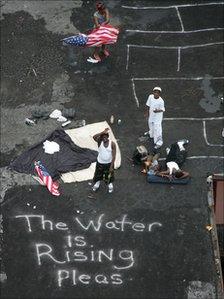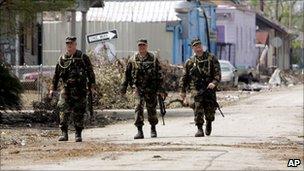How New Orleans descended into post-Katrina chaos
- Published

The Superdome stadium became a 'refuge of last resort' for 26,000 people
On the morning of Monday 29 August 2005 the eye of Hurricane Katrina passed over New Orleans, bringing death and chaos into the heart of the city.
Five years on, indictments against several New Orleans' police officers indicate that some of that chaos was exacerbated by the very people who were supposed to serve and protect the city's inhabitants.
Although Katrina had been downgraded to a Category Four storm - one level down from the highest possible rating - it was still pushing winds of about 160 km/h when the eye moved over the eastern edge of the city.
The accompanying storm surge overwhelmed the network of levees protecting New Orleans from Lake Ponchartrain, flooding low-lying areas.

Katrina left 80% of New Orleans under water
Almost 24-hours before the hurricane hit, aware of the storm' s magnitude and trajectory, Mayor Ray Nagin, had ordered a mandatory evacuation of the whole city.
The vast majority of residents left, but some - including those too poor to have their own transport, the aged and infirm - stayed, and battened down the hatches.
The city government established several "refuges of last resort" for those who could not leave, including the massive Louisiana Superdome stadium, which sheltered approximately 26,000 people as the storm came ashore.
By 31 August, an estimated 80% of New Orleans was underwater. The power, water and sewage systems had been knocked out and the city was rendered uninhabitable.
Law and order across the city broke down as people began looting stores and homes. Many were in search of food and water, but some were taking the opportunity to steal non-essential items.
'Marauding gangs'
Rumour and the chaotic situation on the ground combined until the news was awash with stories of murders, thefts, and rapes.
On-site reporters for some of America's biggest national broadcasters painted a picture of a city swarming with marauding gangs of young men, who were attacking people and attempting to rape women.

As the hurricane moved off the situation for many deteriorated rapidly
Although it may not have been not explicitly stated, the reports appeared to be focussed on African-Americans - who made up the great majority of residents who remained behind.
The hyperbole of the press was shared by officials overseeing the relief and rescue effort.
As she sent in National Guard troops to deal with the "hoodlums", Louisiana's governor at the time, Kathleen Blanco, warned:
"They have M16s and are locked and loaded. These troops know how to shoot and kill and I expect they will."
The Superdome, and the other big refuge, Convention Center, became a particular focus for tales of horror.
On 1 September, New Orleans Police Chief Eddie Compass said "we have individuals who are getting raped, we have individuals who are getting beaten".
Five days later, in an interview with Oprah Winfrey he went even further, saying of the situation inside the Superdome:
"We had little babies in there, some of the little babies getting raped."
Shift in perception
New Orleans Mayor C Ray Nagin, who was interviewed on the same programme, concurred, saying:
"They have people standing out there, have been in that frickin' Superdome for five days watching dead bodies, watching hooligans killing people, raping people."

The National Guard were deployed to combat the 'hooligans'
In these febrile conditions the image of New Orleans transformed: from a city of natural disaster victims, to a hostile environment where criminality had spiralled completely out of control.
However, for the most part, the stories of looting, rape and murder were vastly exaggerated.
In the end of the only six people were confirmed as having died at the Superdome - four from natural causes, one from a drug overdose, and one a suicide.
At the Convention Center, four bodies were recovered - one of whom was believed to have been murdered.
Cover-up
Uncovering the truth about what really happened in New Orleans during those chaotic days after the hurricane hit has been a long process - and one which continues to this day.
On Tuesday, US federal officials announced indictments against four police officers and two supervisors in an investigation into the deaths of two unarmed civilians on New Orleans' Danziger Bridge on 4 September 2005.
According to a US Justice Department indictment, four police officers - Kenneth Bowen, Robert Gisevius, Robert Faulcon and Anthony Villavaso - opened fire on a family on the east side of Danziger Bridge, killing a 17-year-old boy and injuring three other people.
Minutes later, officers were involved in a second shooting on the west side of the bridge, resulting in the death of Ronald Madison, a 40-year-old man with learning difficulties, the indictment says.
The indictment also says police supervisors Arthur Kaufman and Gerard Dugue helped the other officers to obstruct justice during subsequent investigations into the shootings.